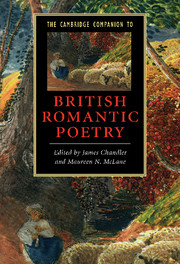Book contents
- Frontmatter
- Introduction: The companionable forms of Romantic poetry
- 1 The living pantheon of poets in 1820: pantheon or canon?
- 2 Romantic poetry and antiquity
- 3 Romantic meter and form
- 4 Romantic poetry and the standardization of English
- 5 Thinking in verse
- 6 Romantic poetry and the romantic novel
- 7 Wordsworth’s great Ode: Romanticism and the progress of poetry
- 8 Romantic poetry, sexuality, gender
- 9 Poetry, peripheries and empire
- 10 Romantic poetry and the science of nostalgia
- 11 Rethinking Romantic poetry and history: lyric resistance, lyric seduction
- 12 The medium of Romantic poetry
- 13 Romantic poets and contemporary poetry
- Index
- Series List
7 - Wordsworth’s great Ode: Romanticism and the progress of poetry
Published online by Cambridge University Press: 28 November 2008
- Frontmatter
- Introduction: The companionable forms of Romantic poetry
- 1 The living pantheon of poets in 1820: pantheon or canon?
- 2 Romantic poetry and antiquity
- 3 Romantic meter and form
- 4 Romantic poetry and the standardization of English
- 5 Thinking in verse
- 6 Romantic poetry and the romantic novel
- 7 Wordsworth’s great Ode: Romanticism and the progress of poetry
- 8 Romantic poetry, sexuality, gender
- 9 Poetry, peripheries and empire
- 10 Romantic poetry and the science of nostalgia
- 11 Rethinking Romantic poetry and history: lyric resistance, lyric seduction
- 12 The medium of Romantic poetry
- 13 Romantic poets and contemporary poetry
- Index
- Series List
Summary
Having agreed that this volume should include a chapter on a single Romantic poem, and that I would write it, I chose the lyric that came to bear the unwieldy title “Ode: Intimations of Immortality from Recollections of Early Childhood,” first published in 1807. Wordsworth composed this poem over two intensive periods of work in 1802 and 1804, the heart of his great decade of creativity. The two-year gap after the composition of the Ode's first four stanzas can perhaps be taken as a measure of the challenge it posed to him. The result of his labors, in any case, is arguably the most important lyric poem of an age known for its lyric poetry. Furthermore, it forms a crucial link in several canonical chains of English poetry that run through the period. For later lyric poets in the nineteenth century, Wordsworth's “second selves,” as he once called them, the Ode loomed as large as anything he ever wrote, including the more professedly experimental poems of Lyrical Ballads and the longer, more ambitious works such as The Excursion and his posthumously published autobiographical poem, The Prelude. In seminal lyrics by Keats, Shelley, and Browning, the Ode set the very terms of poetic engagement with Wordsworth and what he came to stand for. At the same time, the Ode also connected allusively to some important poems of the century before, including to lyrics written in the post-Augustan genre known as the “progress poem.” This latter point, about the progress poem, has not been much addressed in modern critical commentary on the Ode, and I want to suggest that it is crucial for understanding how the Ode establishes its exemplary role in British Romantic poetry and its own place in the history of the lyric, both retroactively and proactively.
- Type
- Chapter
- Information
- The Cambridge Companion to British Romantic Poetry , pp. 136 - 154Publisher: Cambridge University PressPrint publication year: 2008
- 6
- Cited by



